Does your lawn appear to have dead patches with pink or red fibres or little balls of pink fuzz running through them?
Chances are you’re looking at one of the most common lawn diseases around;
Red Thread, which is also seen alongside another disease called Pink Patch.
What is Red Thread and Pink Patch?
Like I said at the beginning, Red Thread is the most common lawn disease in the UK.
It can appear at any time of the year but is most visible in summer. It will often appear in conjunction with another disease called Pink Patch.
It’s a fungal disease caused by a fungus called Laetisaria fuciformis. This fungus is present in nearly all lawns, nearly all of the time.
Chances are that your lawn has even had a Red Thread infection in the past and you’ve never even noticed it. But when conditions are right, you’ll notice blotchy, pinky patches of dead grass as it kills the grass leaves (not the plant itself).
Although it can infect any and all lawns, it particularly likes lawns that contain fescues, particularly Red Fescue, as well as bents, perennial rye-grass, and annual meadow grass.
The good news is that Red Thread doesn’t cause significant damage like other fungal diseases (like Dry Patch or Fairy Rings) so it can be fixed fairly easily.
What Causes Red Thread and Pink Patch to Develop?
Red Thread and Pink Patch can develop at any time of year but is most common during wet and humid summers. That said, if conditions are mild, it’ll last well into the autumn.
Early and late summer mornings with heavy dew provide excellent conditions for the growth and spread of Red Thread and Pink Patch. That said, the drying effect of the summer sun can sometimes mislead people into thinking that the lawn is suffering from drought conditions. So make sure you diagnose the problem correctly before treating it.
Red Thread also prefers lawns that grow slowly due to a lack of nitrogen.
How to Identify Red Thread and Pink Patch
Red Thread and Pink Patch are fairly easy to spot;
- You’ll notice patches of grass turning a pinkish colour before the leaves die and turn brown.
- The patches of discoloured or dead grass can range in size from 5cm (similar to Dollar Spot Disease) to 30cm in diameter. Sometimes these patches can join up to create a much larger area.
Within these patches, you’ll find one of, and often both of the following fungal growths;
Red Thread
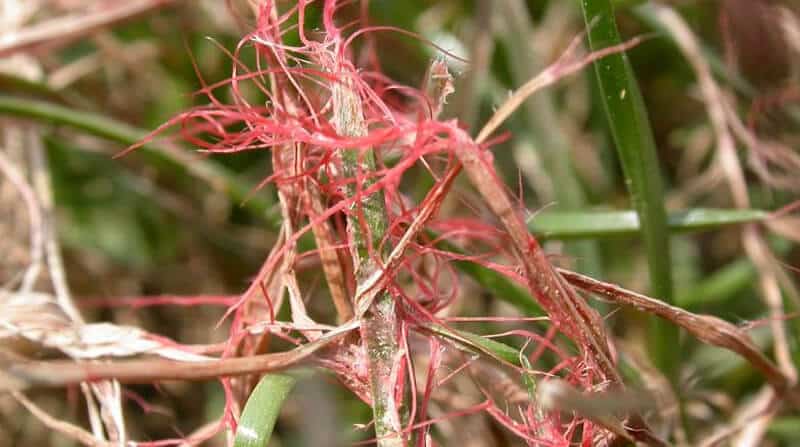
You’ll see tiny pink or red threadlike structures called ‘Stromata’, around 1-2mm in length which grows from the grass leaves.
Pink Patch
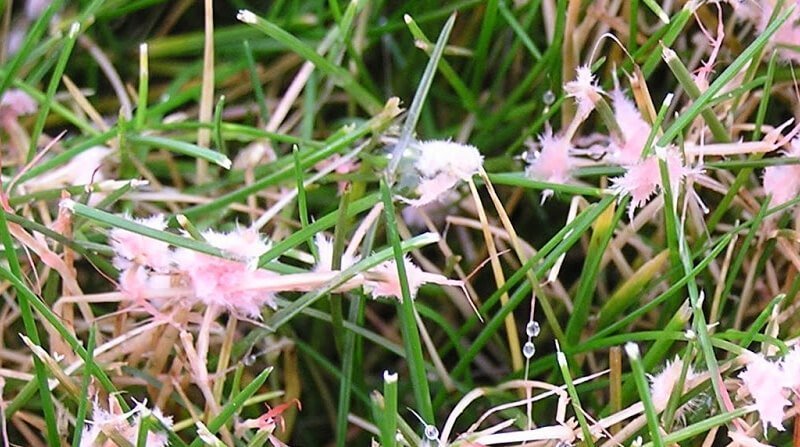
This is sometimes confused with Fusarium Patch or Snow Mould. You’ll now it’s Pink Patch because the fungal growth takes form in small distinctive cottony balls that are pink in colour. Snow Mould more resembles a spiders web.
How to Cure Your Lawn of Red Thread and Pink Patch
The good news is that Red Thread and Pink Patch are relatively easy to fix. But it is a two-step process.
Step 1: Apply a Summer Fertiliser
Red Thread and Pink Patch favour lawns that are deficient in nitrogen so the first step is to apply a summer fertiliser.
This will put much-needed nitrogen back into the soil which will aid grass growth and health.
Do this in the summer, NOT the autumn. If you apply it too late in the year you run the risk of your lawn becoming infected with Fusarium Patch as the weather turns colder.
Water it in and wait a couple of weeks and then…
Step 2: Apply a Fungicide
The only fungicide available for amateur and home gardeners is called Provanto Lawn Disease Control.
- Easy to use
- Use all year round
It does a pretty good job of killing and controlling Red Thread and Pink Patch. Especially when you catch it early.
All you need to do it add it to water and apply it to your lawn with either a watering can or knapsack sprayer.
How to Prevent Red Thread and Pink Patch From Occurring (or Re-Occurring)
Good lawn care practices are what ‘s going to prevent Red Thread and Pink Patch. So when you’re going through your annual lawn care routine, consider the following;
Cut the Lawn Regularly

Regular cutting of the grass will have a huge impact on the overall health of your lawn.
Just by simply cutting your grass more often you’ll see how much thicker and greener it will become.
When you prevent the grass from growing tall (by cutting it) it is forced to grow sideways. It grows new shoots and runners which sprout new grass leaves, making the lawn much thicker and healthier.
Thicker, healthier grass is more able to fight off diseases like Red Thread and Pink Patch as well as moss infestations and outbreaks of weeds.
So cut the grass at leave every 10 days. When growing conditions are at their best in the spring and autumn, cut it every 7 days.
Read: Types of Lawn Mowers You Can Buy
Scarify and Aerate Your Lawn
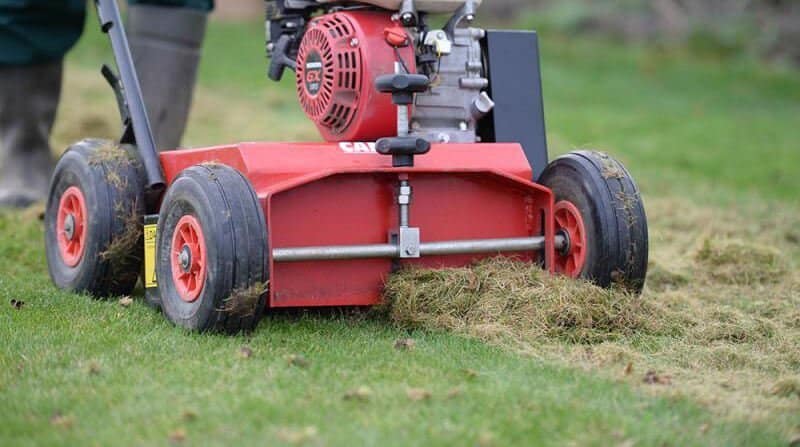
Soil compaction and excess lawn thatch prevent good grass growth, make your lawn weak and more prone to disease.
Scarifying the grass will remove excess lawn thatch and dead organic material.
The removal of this thatch enables water, oxygen and nutrients to penetrate the soil so the grass’ roots and consume them, produce food and grow. It also creates room for new shoots and runners to grow into.
Aerating your lawn involves spiking it with a garden fork, a rolling spiker or aeration shoes to a depth of 2-3 inches. Again, this allows water, air and nutrients to penetrate the soil so the grass can use them.
Hollow tining involves removing cores of turf from the lawn. This creates room for compacted soil particles to relax and separate from each other which in turn, helps the penetration of oxygen, water and nutrients. It also makes it easier for the grass to grow strong roots.
Read: What is the Best Scarifier: Manual, Electric or Petrol? Plus, My Top Recommendations
Fertilise Your Lawn At Least Once a Year
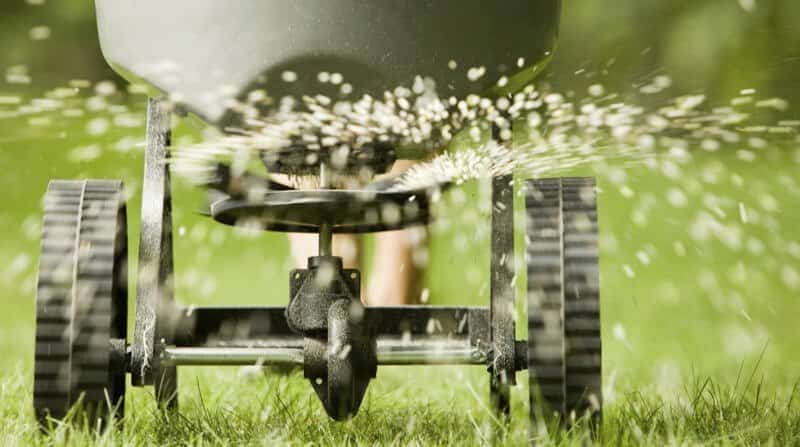
As you now know, Red Thread and Pink Patch prefer lawns that are deficient in nitrogen.
Nitrogen plays a huge role in keeping your grass strong and healthy by;
- Forming cells and grass growth
- Helping to create chlorophyll (what makes the grass green) which is used in photosynthesis
- Promoting flowering and seeding
- Improving root development
The best course of action would be to fertilise your lawn 4 times a year with a fertiliser that is specific for Spring, Summer, Autumn and Winter.
However, if you’re not so green fingered…
…Just apply a good quality, slow-release fertiliser with a decent amount of nitrogen in it just once a year.
If you want to know lawn feed to choose, I wrote a buyer’s guide with my top recommendations.
You’ll notice a huge difference and your lawn will thank you for it.
When it’s Dry, Water Your Lawn Deeply, Once a Week, In the Mornings
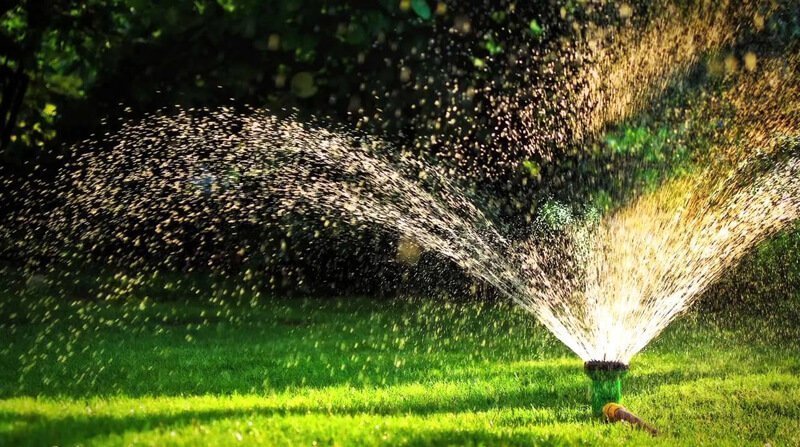
Watering the lawn is one of those tasks that is so simple, yet many people get wrong.
When the weather is dry, millions of gardeners all over the UK flock out to their lawns and give them a sprinkling with their hosepipes.
This will almost guarantee that your lawn will get an infection of Red Thread and/or Pink Patch.
The whole point of ‘watering the grass‘ is to make the soil moist so the grass can absorb it via its roots. Watering your lawn lightly in the evenings does nothing more than wet the grasses leaves, giving the fungus the moisture it needs to incubate and grow.
In order to get that moisture into the soil, you need to water heavily, to a depth of between 1-2 inches. That means watering the lawn once a week for about an hour.
And water the lawn in the mornings. Any moisture left on the grass will be dried by the day’s sun instead of being used to incubate fungal disease.
Apply a Fungicide in the Spring and Autumn
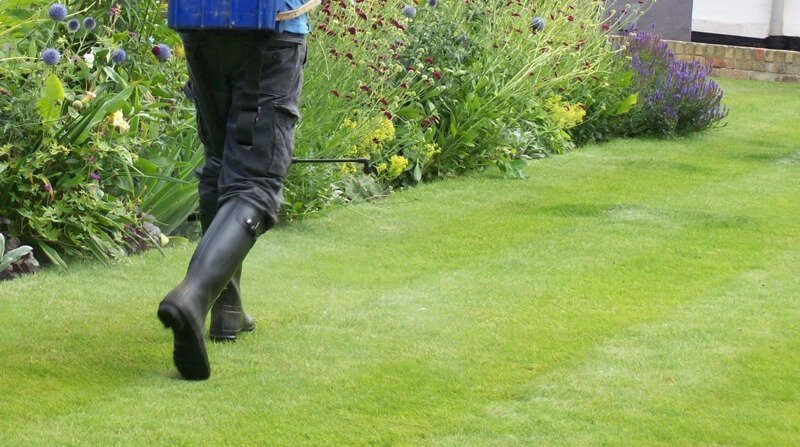
Most people only react to Red Thread and/or Pink Patch when they see an outbreak.
However, one of the best ways to avoid an outbreak altogether is to apply a fungicide in the Spring (May) and Autumn (September).
Provanto Lawn Disease Control can be applied twice a year so why not apply it as a precautionary measure? It’ll cost less and cause less stress than an outbreak would.
- Easy to use
- Use all year round
In Conclusion
Red Thread and Pink Patch aren’t major diseases and can be treated pretty easily. They can also be prevented when you employ a good lawn care schedule.
Now it’s Over to You
Have you got or have you had Red Thread or Pink Patch in your lawn?
Let me know about your experiences in the comments section and if you have any questions, I’ll be happy to answer them.
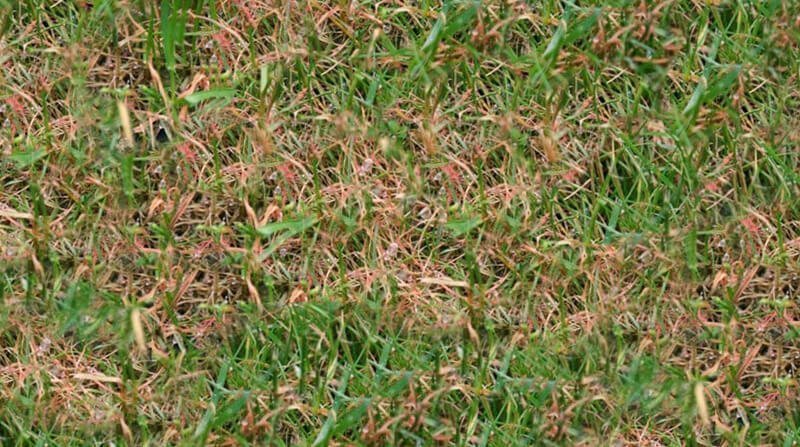


Thankyou very much for your info on red/pink patch. I have just laid a small area of turf and after much care in watering to establish the lawn, I was very upset to see that it has the conditions you describe. I did initially treat it with Miracle Gro Lawn feed to encourage a good growth, but obviously need to obtain a fertilizer with nitrogen, and then follow your advice with a fungicide.
Thankyou very much for all your advice and instructions